Two German publications, newspaper Süddeutsche Zeitung and tabloid magazine Bild, published stories in August 2025 with an image showing freelance photojournalist Anas Zayed Fteiha in the act of capturing a photograph of a crowd of Palestinians waiting for food in Gaza as the Israel-Hamas war ground on. Both publications claimed that photographers in Gaza, including Fteiha, had placed “some of these images … in a false or misleading context.” Bild explicitly accused Fteiha of “staging Hamas propaganda.”
The claim circulated widely online, including via the official X account of Israel. Many social media accounts further claimed photographers had staged a photo used on the cover of Time magazine depicting people waiting for food and that it had also been taken by Fteiha. However, a different photographer, Ali Jadallah, took the Time cover image.
We examined multiple angles of the scene in question and found they showed the people photographed were indeed waiting for food and did receive it from aid workers. We found that a banner indicated they were receiving food from a “kitchen,” or aid distribution site, and workers distributing the food wore vests that displayed the logo of a real charity. The German publications did not include these contextual details.
The child depicted at the center of the Time magazine cover photo personally confirmed to Snopes that on the day the photograph was taken, she was waiting “from the morning to the afternoon” to get her siblings a plate of food.
As starvation in Gaza reached a tipping point in August 2025 during the Israel-Hamas war, images of people vying for food at distribution centers spread across international media, including on a Time magazine cover featuring children holding out empty pots. “The Gaza Tragedy,” the cover read.
The comments under Time’s Instagram post (archived) about the story overwhelmingly denied the authenticity of the image, with dozens accusing the magazine of using a “staged” photo. Posts of the cover on other social media platforms garnered the same reaction:
Claims that Palestinians staged incidents of death and suffering, though circulated online for years, heated up following an Aug. 3 story by German newspaper Süddeutsche Zeitung that claimed photographers in Gaza placed “some of these images … in a false or misleading context.”
“I assume that many of these images of starving and sick children are simply staged or come from other contexts,” Gerhard Paul, one of the experts quoted in the SZ story said (translation from German via Google Translate). “These are not fakes … but the people are presented in a certain way or given a misleading caption to mobilize our visual memory and our emotions.”
Another German publication, the tabloid magazine Bild, published a widely shared story titled “This Gaza photographer stages Hamas propaganda” on Aug. 5 that pointed to the SZ story and further claimed that, in particular, Gazan photographer Anas Zayed Fteiha “staged” photos of people vying for food to the “benefit of Hamas and its propaganda.”
On Aug. 7, Israel’s official X account echoed these claims (archived), saying Bild exposed “Pallywood” (a derogatory term used to accuse Palestinians of staging suffering and death).
Below, we break down the evidence surrounding the claim that Fteiha staged photographs and that the Time magazine cover also featured a staged image:
Did Anas Zayed Fteiha ‘stage’ the photos?
The main image — and primary evidence — for both the Bild and SZ stories was a shot of Fteiha crouching in front of a group of people holding large pots behind a metal fence.
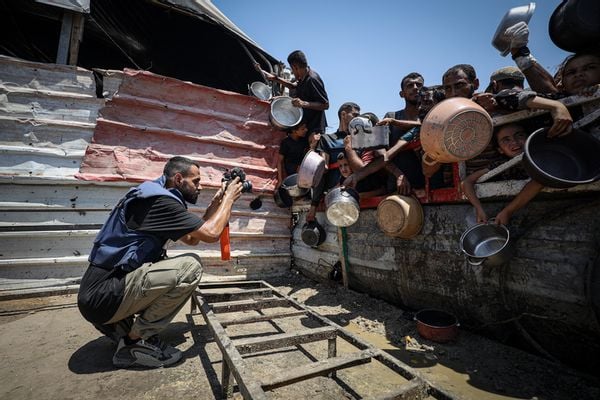
(Getty Images)
The image is authentic; it’s available on Getty Images with the caption:
Journalists document daily struggles amid Gaza humanitarian crisis due to Israeli attacks
GAZA CITY, GAZA – JULY 24: Anadolu freelance photojournalist Anas Zeyad Fteha documents the struggle of displaced Palestinians to access food, while often facing hunger himself as Anadolu freelance journalists continue their work under difficult conditions to shed light on the humanitarian impact of Israeli attacks on Gaza on July 24, 2025. (Photo by Khames Alrefi/Anadolu via Getty Images)
Without context, it’s possible for viewers to misconstrue the image as staged. However, another angle of the same location — slightly later, it appears — shows Fteiha standing above the crowd while they receive food from aid workers.
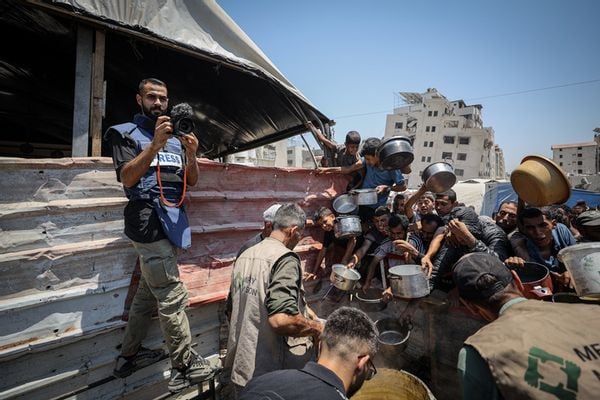
(Getty Images)
With this contextual evidence, the crowd Fteiha photographed indeed appears to be waiting for food, not standing at that location with pots in hand for the sole purpose of capturing a photo.
Further evidence confirms this. For example, the aid workers seen distributing food wore vests with the logo of a real charity that distributes food in Gaza, though the image’s caption did not mention them. The logo displaying interlocked green hands belongs to Pakistani charity Mercy Mission. We requested comment from the charity regarding the claim of staged photos and will update this story if we receive a response.
The SZ story claimed: “In fact, there are photos of people with empty pots in Gaza that show they aren’t standing in front of a food bank, but in front of a photographer.”
A zoomed-out image from another angle shows Fteiha standing between the crowd surrounding the fenced-in area on at least two sides and a building with a banner on it indicating that it is a “kitchen” or food distribution center (circled in red).
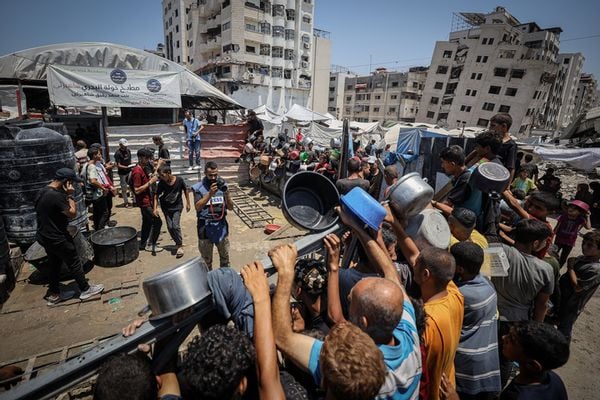
(Getty Images)
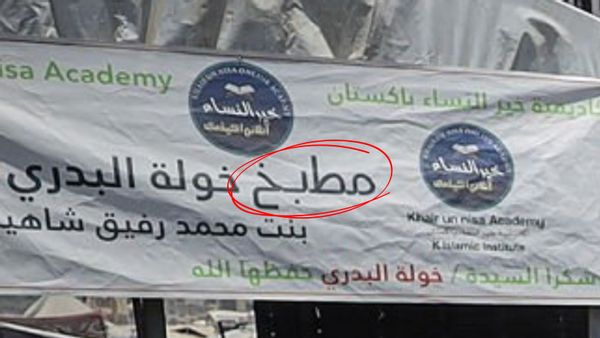
(Getty Images)
According to the Bild story, both Agence France-Presse and the German Press Agency said they would not “cooperate” with Fteiha and that “they carefully review the images of other photojournalists and their reputations before publication.” Bild also said it reached out to Reuters, which said that its photos “meet the standards of accuracy, independence, and impartiality.” Fteiha denied the claims that he staged photographs on his Instagram account, writing:
My message to the public:
Don’t be misled by the biased media. Look closely at the pictures, at the details, at the blood that is spilled, at the children starving. Hunger does not defame you, fear does not represent.
I work as a journalist with the Turkish Anatolian agency, I do not belong to any other party, and I do not work for anyone but the truth.
He also noted in the Instagram post that he was filming for a documentary “documenting the famine in Gaza, as children were struggling for food or water. Everything in it was a live reality, no acting or direction. I was doing my journalism job honestly and honorably, I never directed a scene or asked anyone for anything.” We reached out to him for further comment and will update this story if we receive a response.
Finally, Fteiha’s own video footage available on the Getty Images website and dated the same day, July 24, further shows that people were waiting for food, and not just posing for photos. A video published by Al Jazeera on Aug. 1 shows what appears to be the same distribution site (red metal siding flanks the same wall). In the video, Gazans wait for food before aid workers began distributing it.
Bild is not regarded as a highly credible source of factual information; in 2004 alone, the press watchdog German Press Council publicly reprimanded the outlet 12 times.
Although many online referred to SZ’s story — which formed the basis for the Bild story — as an “investigation,” it primarily consisted of the testimony of two experts — Christopher Resch, Middle East spokesperson for Reporters Without Borders, and Gerhard Paul, retired history professor and claimed photography expert. The story did not reveal any hard evidence that Fteiha staged the photographs.
Is there proof photographers staged the Time cover?
Multiple popular posts incorrectly credited Fteiha for photographing the Time magazine cover depicting children waiting for food. “A German investigation has revealed Palestinian photor [sic] Anas Zayed Fteiha staged & falsified his work – including an image that made it onto the cover of TIME Magazine!” one post read.
But Fteiha did not take the image featured on Time’s cover. A different photographer, Ali Jadallah, took the photo on July 22, according to Getty Images. Another angle available on Getty Images shows the girl at the center of the image receiving soup; the green bucket next to her is another visual indicator that the scene matches that of the Time magazine cover photo on Getty Images.
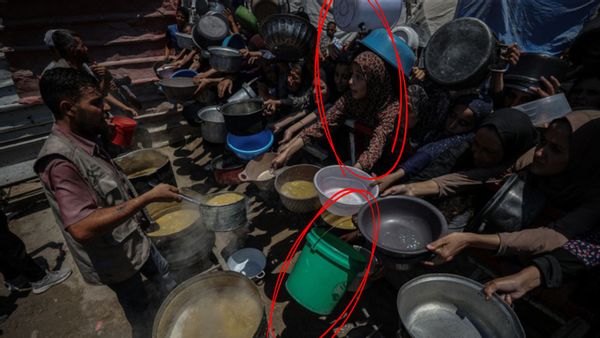
(Getty Images)
Snopes established contact with the girl featured on the cover via Instagram, and she confirmed her identity with a video message in which she shared her side of the story while wearing the same clothes pictured on the magazine cover, saying (translation via native Arabic speaker):
Hello. I’m the girl that appeared on the American Time magazine, when I was getting food for my siblings from the charity center. I stayed from the morning to the afternoon until I got them a plate of food. The same day, a girl fainted from lack of food and another girl poured a pot of food over her. Before the war we had a home but it was destroyed. We’re living in a tent, a big family, eight people. I’m requesting your help for me and my family, we really need your help.
In addition to the other angles of the scene available on Getty Images that show those featured on the magazine’s cover receiving food from aid workers as opposed to simply posing for photos, the child at the center of the Time cover confirmed her own account that she was waiting for food “from the morning to the afternoon.”
In sum …
While other instances of photographers in Gaza “staging” photoshoots that convey a false reality in order to elicit emotional responses may have taken place, the two instances we investigated above did not. Extensive, publicly available documentation confirms that the people in the images above were, in fact, waiting for food from aid distribution centers.
The hunger on display in the images and footage is consistent with reality; more than 20,000 children were admitted for treatment for acute malnutrition in Gaza between April and mid-July and “the food consumption threshold for Famine (IPC AFI Phase 5) has already been passed for most areas of the Gaza Strip,” according to the Integrated Food Security Phase Classification, the foremost authority on global food security.

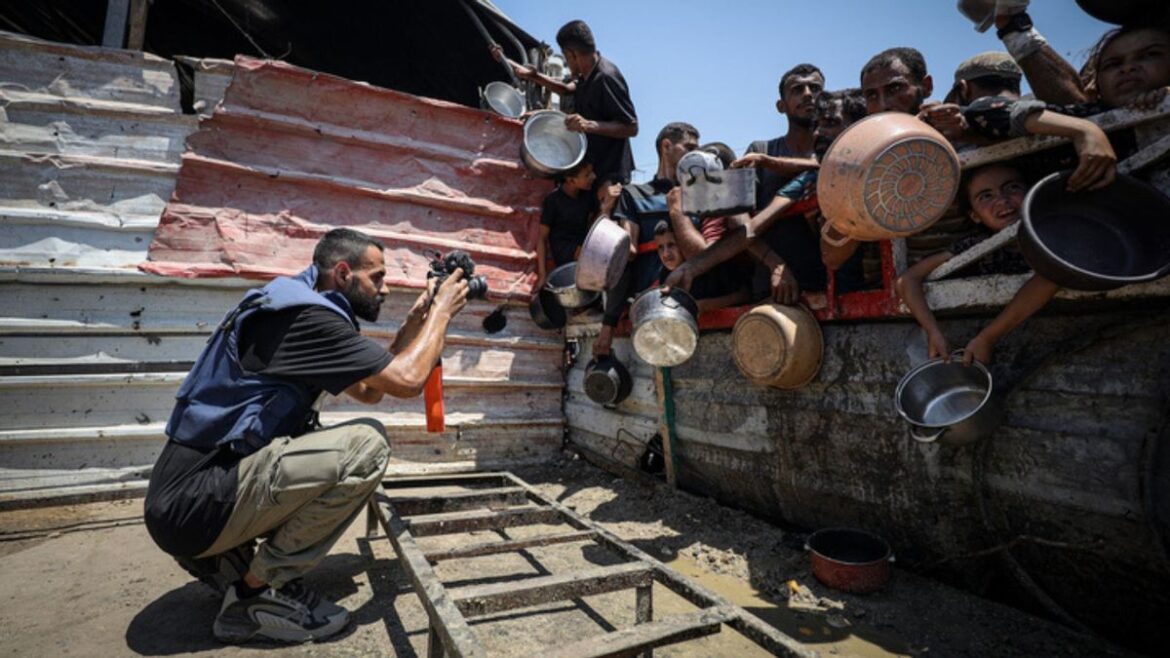
Dining and Cooking